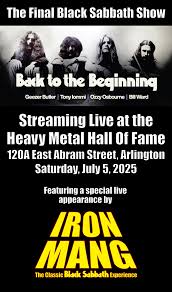“Back to the Beginning or Back to the Mixing Board? Fans Question Delay and Audio Alteration in Streamed Black Sabbath Performance….
Villa Park, Birmingham – July 7, 2025 – What was expected to be a triumphant, unfiltered celebration of Black Sabbath’s legacy at the much-hyped Back to the Beginning concert has now ignited a curious firestorm among longtime fans. Following a two-hour delay in the live stream of the event and growing whispers about possible post-production enhancements—particularly to Ozzy Osbourne’s vocals—the Sabbath faithful are asking: was what we saw and heard truly live?
The performance, which reunited Ozzy Osbourne, Tony Iommi, Geezer Butler, and Bill Ward on stage for the first time in over 20 years, was a historic moment in rock history. Fans at the venue experienced the raw, gritty edge of a band that, despite age and ailments, gave everything to honor the music they helped create. But those watching the stream, which aired two hours after the live set, noticed something different—and now, they’re speaking out.
A growing number of Black Sabbath enthusiasts have voiced concern over the integrity of the streamed version. Many pointed to the obvious disparity between Ozzy Osbourne’s live vocal performance—noticeably shaky in the early moments of “War Pigs”—and the more polished, surprisingly in-tune version heard in the delayed stream. Some now suspect post-production manipulation, particularly pitch correction or audio sweetening, was used to clean up the Prince of Darkness’s vocals before the digital audience tuned in.
“Something felt too smooth,” one fan wrote on a now-deleted social media post that featured a recording of the stream. “Ozzy’s voice was a bit of a mess in person—god bless him—but the stream made him sound almost like it was 1992 again.”
Indeed, physical attendees have come forward saying that Ozzy, while spirited and full of charisma, struggled vocally through the opening tracks. “War Pigs” in particular showed the wear and tear of his years, with some lyrics coming out off-key or buried under the band’s massive wall of sound. But the streamed version told a cleaner story, with tightened audio levels and notably more even vocal lines.
This has led to speculation that the two-hour delay was more than just a buffer for selecting optimal camera angles. Industry insiders suggest that rapid post-show audio processing is not uncommon in high-profile digital broadcasts, particularly for legacy acts under intense scrutiny. Digital pitch-shifting and real-time audio mastering can now be applied quickly—sometimes within minutes—to enhance a vocal track while maintaining the illusion of a “live” experience.
While there’s no official statement yet from the production team behind Back to the Beginning, the absence of transparency has only fueled the conversation. Former sound engineers and video editors have chimed in anonymously across forums, suggesting that subtle pitch correction and compression may indeed have been applied to preserve the dignity of the performance, especially given the massive global audience tuning in.
Still, for fans who’ve followed Sabbath since the early ’70s, this moment was about authenticity. “We didn’t come for perfection,” said Sheila Merton, 68, who attended the concert in person. “We came for Sabbath—warts and all. Ozzy just being there was everything.”
To make matters more mysterious, the few fan-uploaded versions of the original stream—which might have allowed side-by-side comparison with the live vocals—have now been taken down across major platforms. Whether this is due to copyright claims or something more intentional is up for debate.
Regardless of any post-production edits, the night at Villa Park was emotionally charged and historic. Bill Ward’s return to the drum kit brought tears to fans’ eyes, and Tony Iommi’s riffs rang out like thunder. But the discrepancy between what the crowd witnessed and what was streamed has now become a story of its own—one that cuts to the heart of the balance between preserving legacy and maintaining artistic truth.
For some, this moment has sparked nostalgia, controversy, and admiration all at once.
“I’ve loved Sabbath since I bought Vol. 4 on vinyl in ’72,” said longtime fan Robert Menzies. “But I’d rather hear Ozzy wail out of tune with soul than have a plastic-perfect version of what he once was.”
Until official statements are made—or if alternate footage ever leaks—the truth may remain a mystery. But the questions raised speak volumes about the modern music industry’s approach to legacy, presentation, and what we, the audience, are allowed to hear.
